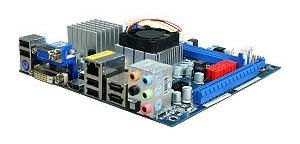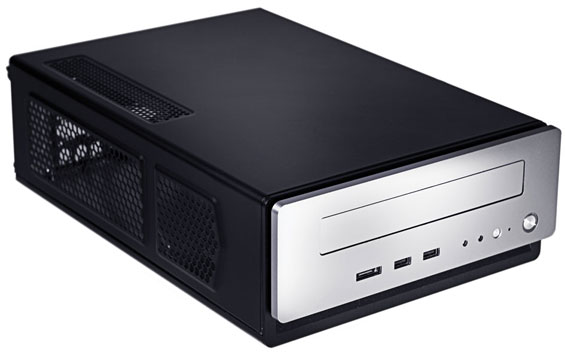Nettop and Mini-ITX Buyer’s Guide
by Zach Throckmorton on April 22, 2011 2:00 PM ESTIntel Upgraded HTPC Nettop
| Intel Upgraded HTPC Nettop | ||
| Component | Product Name | Price |
| CPU + Mobo | ASRock A330ION (Atom 330 + NVIDIA ION) | $120 |
| Memory | Patriot 4GB (2x2GB) PSD34G1333K | $40 |
| Case + PSU | Antec ISK310-150 Black/Silver + 150W PSU | $80 |
| Storage | Samsung SpinPoint MP4 HM640JJ 640GB 7200RPM 16MB | $60 |
| Optical Drive | Sony Optiarc BC-5500H-01 BR-ROM/DVD-ROM | $90 |
| Operating System | Windows 7 Home Premium 64-bit | $100 |
| Extra Software | CyberLink PowerDVD 11 Ultra | $100 |
| Total Price | $590 | |
For our upgraded configurations, we’re going to look into making something that’s a bit more capable as an HTPC. On the Atom side, the only way you can do that is if you get a better GPU than the 3150, and the easiest (and cheapest) way to do that is to purchase an ION motherboard. With the arrival of AMD’s Brazos, most motherboard manufacturers are shifting to that platform. It certainly doesn’t help that when Intel moved from the original Atom platform to Pine Trail, they integrated the Northbridge into the CPU package and  essentially killed off the ION chipset, so now you’d have to get a Pine Trail board with a PCIe slot if you wanted a discrete GPU. The result of all this is that we’re sticking with the older Atom 330 + ION for our upgraded Intel configuration, which is not without drawbacks.
essentially killed off the ION chipset, so now you’d have to get a Pine Trail board with a PCIe slot if you wanted a discrete GPU. The result of all this is that we’re sticking with the older Atom 330 + ION for our upgraded Intel configuration, which is not without drawbacks.
For this setup, we’ve selected the ASRock A330ION board, but availability and pricing can be a little sketchy on any of these older ION boards. As one of the major flaws with the Atom platform was its inability to play HD video smoothly, NVIDIA used their ION (a rebadged 9400M chipset) to address this issue. Paired with the dual-core Atom 330 CPU, this platform can play HD videos and even Blu-ray content—though not 3D Blu-ray. The ASRock board also has VGA, DVI, and HDMI ports. We first looked at the ION platform almost two years ago, and you can still get a good idea of its capabilities and limitations from our original assessment. For the memory, we’re again using desktop DIMMs, but now we’re upgrading to 4GB (2x2GB) of Patriot memory. The basic desktop DDR3 kits seem to have bottomed out at around $40 shipped without rebates. 2GB is sufficient, but the $18 extra can provide more headroom for multitasking.

The remaining components once again depend on the case selection, and we’ve selected the upgraded Antec ISK310-150 this time. We like this case a lot because it comes with a reasonably quiet 80mm fan, typical minimalist Antec aesthetics, and uses an external power adapter (which makes no noise, and is more efficient than internal power supplies—especially considering these low-powered nettops draw at most 25-30% of even a low wattage 150W PSU). It’s also available with a black bezel if you prefer that to the silver bezel. As with the ISK 100, this case uses 2.5” laptop hard drives, not 3.5” desktop hard drives. We’re only using one HDD again, but this case can fit two drives so SSD + storage drive is again an option.
For the hard drive, we’re going to offer an alternative to the 500GB Seagate that has seen so much use in laptops during the past year. Samsung recently launched their 640GB 7200RPM SpinPoint MP4 HM640JJ, at the same $60 price point as the Seagate. The higher areal density should improve sequential transfer speeds, and it will certainly be faster than the 5400RPM laptop drives. For the optical drive, you could stick with the same Samsung mentioned in the basic Intel configuration, but our upgraded nettops are going to take more of an HTPC role so we’re going the Blu-ray route. Slim BD-ROMs are difficult to find for less than $100, and in fact this is the only slim BD-ROM Newegg currently stocks. Note that it’s a DVD-ROM as well, so there are no burning capabilities to speak of—we suggest you use a different system for burning, and particularly video encoding/transcoding as such tasks can be painfully slow on Atom.
If you’re going to watch Blu-ray movies, you’ll also need appropriate software. The software included with the Sony drive is underwhelming, and CyberLink’s PowerDVD Ultra tends to work well with a variety of platforms. It also happens to cost $100, so you might want to start with the basic Blu-ray software and only upgrade if you want access to other features.
With all of the upgrades and a copy of PowerDVD, the total system cost is nearly double that of the base Atom setup, though much of that comes from choosing to include Blu-ray support. $590 is a lot to pay for an Atom nettop, certainly, and we’ll discuss other options in our conclusion. If you want to skip out on Blu-ray playback, you can get the above system for $400. Using the same case and components, the difference in motherboard choice makes this platform $10 more than the basic AMD E-350 setup, or $37 more than the stock Atom configuration.










101 Comments
View All Comments
Chloiber - Friday, April 22, 2011 - link
You made a small mistake in the table of the AMD Upgraded HTPC Nettop (look at Case/PSU & Storage ;)hnzw rui - Friday, April 22, 2011 - link
Perhaps you should have actually tested these systems prior to making your conclusion. While TDP of the i3-2100T is 35W, actual power consumption particularly at idle is very low. Depending on the specific motherboard used, assuming all other parts are equal, it's possible to get even lower idle power consumption from i3-2100T/H67 than a Zacate E-350 or Intel Atom/NM10. Frankly, even a regular i3-2100's power consumption wouldn't be too far off from Zacate and Atom.Gigantopithecus - Friday, April 22, 2011 - link
I have actually tested these systems... Perhaps you missed this, "we instead chose the lower power i3-2100T that runs at 2.5GHz. Either can frankly run circles around the fastest of the other CPUs we’ve looked at, and while 35W is twice the TDP of the E-350, idle and lower load power shouldn’t be too much more."I have not been able to find a motherboard that idles as low as an E-350 setup with an i3-2100T (all other components being). That said, they do idle at only a few watts more (as the article clearly states). Under load, however, the 2100T systems I've assembled start pulling 10+ more watts from the wall. Obviously this is a small absolute amount of electricity, but it does represent a ~25% relative increase in power consumption. If you're aware of a mini-ITX board that paired with an i3-2100T idles at less than a Zacate mini-ITX board, I'd love to hear what it is!
hnzw rui - Friday, April 22, 2011 - link
http://www.xbitlabs.com/articles/cpu/display/core-...http://www.missingremote.com/review/intel-core-i3-...
As for the i3-2100, at load (Linpack), it only consumes 5W more than the i3-2100T.
In fairness, the Gigabyte board probably has higher power consumption compared to other E-350 motherboards.
Gigantopithecus - Friday, April 22, 2011 - link
There's no probably about it - the Gigabyte board they used in their comparison is one of the most power-hungry Zacate boards I've used. The MSI IS board uses 5-8W less at idle IIRC, dropping it below the 2100T's system idle consumption. Unfortunately, the 2100T by itself costs more than the less expensive Zacate board + APU combos.BforByron - Friday, April 22, 2011 - link
Hey could you guys throw some of the results for the i3-2100T on your bench list. I'm gonna make an HTPC and i want to compare the i3-2100 to the i3-2100T with and without a discreet GPU. I'm thinking of adding a 5770 to it and want to see the overall idle and load power draw as well as some game marksRoland00 - Friday, April 22, 2011 - link
Currently nvidia is making a newer version of their hybrid graphics that will use intel motherboards with nvidia graphic cards (H67 or Z68). The rumored name is "Synergy" and rumor has it will only need a h67 or z68 motherboard and a bios update.http://news.softpedia.com/news/Nvidia-Works-on-Its...
Lucid also is making its own virtu technology. Which anandtech has talked about in the past. Supposedly you can get a beta of this software for free somewhere.
If these technologies work as planned your cpu can use the intel graphics for normal desktop use and keep your gpu in idle, and crank up the gpu to full blast when you throw in a computer game.
Out of Box Experience - Friday, April 22, 2011 - link
Sandy's 35 Watt may indeed idle at a watt or 2 more than the other platforms but given the same battery in a mobile setup, wouldn't the Sandy get a lot more work done with that same battery?If so, then it would be more efficient than a lower powered system
This would be a great RealWorld test for these Low power Sandy Bridge systems
How much work can you get done on the same battery by booting up and running the workload after idling for 20 minutes or so
Seems Realworld to me
ET - Saturday, April 23, 2011 - link
I don't think it's a matter of efficiency as much as a matter of usage. If you're playing videos, the E-350 should be just as good as the i3. If you're doing video conversion, the E-350 isn't even in the running.Still, if you're just looking at idle power than the two setups achieve the same amount of work (i.e., zero work), so I'm a little baffled why you started your comment with a comparison of idle power.
Out of Box Experience - Saturday, April 23, 2011 - link
Quote:"I'm a little baffled why you started your comment with a comparison of idle power."
Me Too!
Where the heck is that Edit function?
I'd still like to see a "Fair" comparison of how much work you can do with a given amount of power
But what would be "Fair" ?